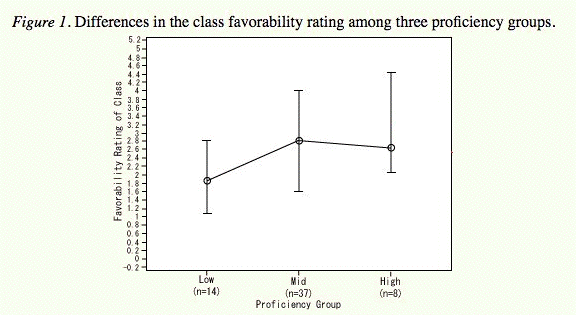Shiken: JALT Testing & Evaluation SIG Newsletter
Vol. 12 No. 1. Jan. 2008. (Supplement) [ISSN 1881-5537]
|
Possible answers for the nine questions about testing/assessment which were in the January 2008 issue of this newsletter appear below. If you feel an answer is unclear or disagree with a conclusion, please contact the editor. |
INSTRUCTIONS (translated from Japanese): Read the sentence below, then select |
|
Further reading: Fowler, H. W. (1908). The King's English, 2nd ed. Oxford: Clarendon Press. Online Edition retrieved January 12, 2008 from http://www.bartleby.com/116/209.html |
|
Further reading: Nelson, L. A. & Crotty, M. (2007, March 6). The ethical use of statistics in research. Retrieved January 12, 2008 from http://www.chass.ncsu.edu/langure/modules/ documents/Ethicaluseofstatisticsdraft1.doc |
|
Further reading: Stockburger, D. W. (n.d.). Introductory statistics: Concepts, models, and applications: One and two-tailed t-tests. Retrieved January 14, 2008 from http://www.psychstat.missouristate.edu/introbook/sbk25m.htm |
|
Further reading: Griffee, D. (1998) Can we validly translate questionnaire items from English to Japanese? Shiken: JALT Testing & Evaluation SIG Newsletter, 2 (2) 15 - 17. Retrieved January 14, 2008 from http://jalt.org/test/gri_1.htm Kataoka, H. C., Koshiyama, Y. & Shibata, S. (2008), Japanese and English ability of students at supplementary schools in the United States. In K. Kondo-Brown & J. D. Brown (Eds.) Teaching Chinese, Japanese, and Korean heritage students: Curriculum needs, materials, and assessment. ESL & Applied Linguistics Professional Series. (pp. 47 - 76). New York & Abingdon, U.K.: Lawrence Erlbaum Associates Nunn, B. (2001). Task-based methodology and sociocultural theory. The Language Teacher, 25 (8). Retrieved January 13, 2008 from http://www.jalt-publications.org/tlt/articles/2001/08/nunn |

|
Further reading: Box plot. (2008, January 11). In Wikipedia, The free encyclopedia. Retrieved January 14, 2008 from http://en.wikipedia.org/wiki/Box_plot Brown, J. D. (1997). Skewness and kurtosis. Shiken: JALT Testing & Evaluation SIG Newsletter, 1 (1) 18 - 20. Retrieved January 14, 2008 from http://jalt.org/test/bro_1.htm Janssen, R.; Tuerlinckx, F.; Meulders, M.; & De Boeck, P. (2000). A hierarchical IRT model for criterion-referenced measurement. Journal of Educational and Behavioral Statistics, 25 (3) 285-306. Mousavi, S. A. (2002). An Encyclopedic Dictionary of Language Testing, (3rd Ed.). Taipei: Tung Hua Book Company. p. 362. |
[ p. 19b ]
|
Further reading: Simon, L. J. (1999). Penn State Department of Statistics: Statistical Education Resource Kit: Confidence Interval for a Mean: PPT Slide. Retrieved January 16, 2008 from http://www.stat.psu.edu/~resources/ClassNotes/ljs_19/ljs_19.PPT - Stone, D. C. & Ellis, J. (2006). Stats Tutorial - Degrees of Freedom. Retrieved January 16, 2008 from http://www.chem.utoronto.ca/coursenotes/analsci/StatsTutorial/DegFree.html Virginia Tech. (1997, 1999). The t-Distribution and its use in hypothesis testing. Retrieved January 16, 2008 from http://simon.cs.vt.edu/SoSci/converted/T-Dist/ |
|
Further reading: Jafarpur, A. (2003). Is the test constructor a facet? Language Testing, 20 (1) 57-87. |
|
Further reading: Garson, G. D. (1998, 2007). PA 765: Research designs. Retrieved January 14, 2008 from http://www2.chass.ncsu.edu/garson/pA765/design.htm |
|
Further reading: Central Virginia Governor's School for Science and Technology. (2003). T-test Distribution. Retrieved January 15, 2008 from http://www.cvgs.k12.va.us/DIGSTATS/main/inferant/d_tdist.htm Garson, G. D. (2007, December 14). Ordinal Association: Gamma, Kendall's tau-b and tau-c, Somers' d. Retrieved January 15, 2008 from http://www2.chass.ncsu.edu/garson/pA765/assocordinal.htm Kendall tau rank correlation coefficient. (2007, October 27). In Wikipedia, the free encyclopedia. Retrieved January 14, 2008 from http://en.wikipedia.org/wiki/Kendall%27s_tau Lohning, H. (2006, March 27). Ordinal Association. Retrieved January 15, 2008 from http://www.statistics4u.info/fundstat_eng/ee_kendall_rank_correlation.html Veenhoven, R. & Kalmijn, W. (2002). World Database of Happiness: Correlational Findings: Correlates of Happiness: Chapter 4. Retrieved January 14, 2008 from http://worlddatabaseofhappiness.eur.nl/hap_cor/introtexts/introcor-contents.htm |
[ p. 20b ]